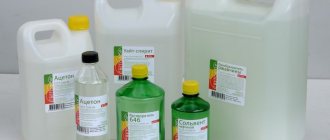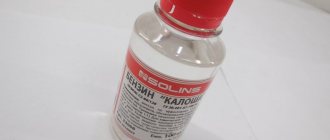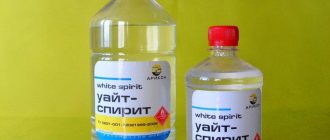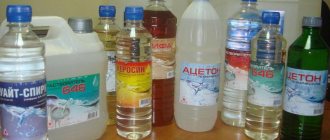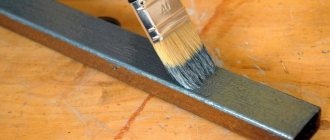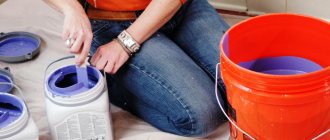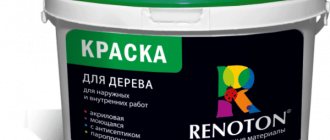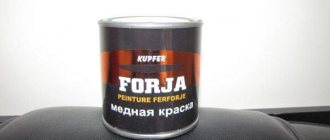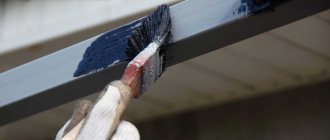Let’s conduct a “debriefing, from the bell tower” of physical and chemical facts regarding the use of acetone, both for its intended purpose and not so much. Children in the first grade probably know about the basic properties of acetone, so we won’t go into details. The main household use of this organic substance is as a solvent. The word solvent means the ability of acetone to dissolve a decent amount of organic substances, which makes it universal in use, unlike narrowly targeted solvents such as toluene, benzene, kerosene, etc. We must not forget about the high evaporation ability of acetone (please do not confuse it with the boiling point), for example, isopropyl and ethyl alcohol have almost the same boiling point, a difference of five degrees, but ethyl alcohol evaporates faster than isopropyl alcohol, all other conditions being the same.
But no matter what ideal solvent acetone is, it is not the basis of the finished product, unless, of course, you use glue for gluing models of airplanes, ships, etc. made from polystyrene! Remember in the USSR they sold such sets, “crazy hands”. In all other respects it is used as an additive. Even nail polish, which fashionistas then allegedly remove with acetone, is also not acetone. In the varnish base, ethyl acetate is used as a solvent, as well as nail polish remover, with a small addition of up to 10% acetone. Acetone is harmful not only to the liver when inhaled, but also to nails, and this is precisely because of its good solubility to almost all substances, especially those of a protolytic nature.
What is stronger - acetone or solvent?
From this article you will learn:
- What is acetone
- Where is it used
- What types of solvents are there?
- What is stronger - acetone or solvent?
- How to work with acetone and other modern solvents
It is unlikely that today you can meet a person who would not be familiar with some type of solvents - they have long become an integral part of our everyday life. You won’t be able to do without them if you perform any work related to painting. People of the older generation probably remember that previously oil paint was diluted with acetone, which was also used if there was a need to remove old paintwork. In this article we will tell you what is stronger - acetone or solvent, we will figure out what the difference between them is, we will tell you what other solvents there are and how to work with them.
Features of metallic paint dilution
Metallic is considered a complex paintwork and requires precise application technology. The product is widely used for painting vehicles (cars and motorcycles). The surface has a metallic reflective sheen. This effect is explained by the presence of special aluminum powder in the material. The finished coating is not affected by corrosion, and the result will please the eye for a long time. However, mechanical stress and disruption of the integrity of the coating will ultimately lead to its destruction. The paint does not fade under the influence of ultraviolet rays of the sun.
What is acetone and where is it used?
Before answering the question of which is stronger – acetone or a solvent, let’s figure out what acetone is. It is a colorless volatile liquid of organic nature with the formula C3H6O. It is the simplest of the saturated ketones and the most common of all solvent types.
Acetone is characterized by the presence of a sharp, specific odor. Among its features, one can note the ease of mixing with water and organic solvents such as ether, ethyl and methyl alcohols. The boiling point of acetone is insignificant - approximately +56.1 °C, melting point - +95 °C. This liquid is flammable and highly flammable.
Recommended articles on the topic:
Acetone was originally obtained by distilling wood. Today, due to the scale and relevance of its production, grain or lemon balm fermentation technologies are used. This substance can also be obtained by controlling hydrocarbon oxidation.
Acetone is essential in various industries and processes. It is used for:
- dissolving varnishes, nitro-varnishes, nitro enamels, acetylene, nitrocellulose, rubber, waxes, fats and other substances;
- removing paint and nail polish;
- dissolving certain salts (for example, potassium iodide, calcium chloride, etc.);
- production of a number of medicines;
- creation of artificial silk;
- production of unbreakable organic glass products and plastics, which are based on cellulose nitrate - celluloid;
- obtaining nitro powder (non-smoking explosive);
- making films for filming, etc.
Due to the ability of acetone to excellently dissolve acetylene, it is actively used when it is necessary to fill steel cylinders that are intended for storing acetylene. In addition, it can be used to easily clean various surfaces and tools from polyurethane foam.
Acetone is a component of many chemical products; without it it is impossible to create perfumes, dyes (for example, indigo), artificial rubber and artificial leather. It is used to effectively disinfect wool and fur. Together with salts of acids (sulphurous and hydrosulphurous) it is used in the processes of dyeing and printing textiles.
Due to the fact that the toxicity of acetone is moderate, it can be used in the pharmaceutical and food industries. It helps in the extraction of a number of drugs, foods, fats, vitamins.
Other interesting questions and answers
Why does sulfuric acid dissolve everything except the jar it is in?
Sulfuric acid does not dissolve everything. In particular, it does not dissolve glass, quartz, many types of plastic, many ceramic materials (for example, porcelain), gold-platinum, etc. and so on. Chemical glassware is usually made of glass or resistant plastic, so sulfuric acid does not dissolve most chemical glassware.
Sulfuric acid dissolves, either, in fact, as an acid (i.e. metals, their oxides/hydroxides, salts of weak acids, etc.), or as an oxidizing agent (organic substances, some non-metal compounds, and in general most of what that at least somehow oxidizes). However, many substances are not compounds of active metals and do not exhibit noticeable reducing properties. Sulfuric acid does not dissolve them or dissolves very slowly - for example, aluminum oxide is theoretically soluble in sulfuric acid, since it is still a metal oxide, albeit with amphoteric properties, but practically for ceramics or a single crystal the dissolution rate is so low that it is negligible and, in principle, possible say that they are resistant to sulfuric acid (although, say, I would not bathe an optical single crystal in sulfuric acid, it may become cloudy, etc.).
There are also some passivation mechanisms when dissolving something theoretically soluble in sulfuric acid (mainly concentrated), but these are details.
Alexander Vanetsev 5
Hello. How to wash microfiber half shoes?
Is it possible to dilute battery paint with color and paint it?
I have two rooms in which I want to paint the batteries beige, I have the brown Dufa color that is used to decorate the walls, and I want to add this color to a can of paint for the batteries, is it worth it?
Why not! Now the white color of heating radiators has long been no longer a constant or mandatory, as in Soviet times in all institutions and organizations. Which, in turn, entailed painting in residential buildings - after all, housing offices were also subject to various decrees, regulations and orders. For example, I have the walls in one room painted golden and I painted the radiators to match the walls, adding ocher pigment to the white paint. The combination is just super, in the other room the walls are slightly with lapis lazuli and the radiators are light blue, rather even light turquoise - it also looks good. So, it all depends on taste and desire! You can immediately buy the paint of the desired color, or you can buy the required pigment separately and mix it with the paint. Pigments are now sold in any hardware store or on the market, the main thing is that the paint holds well the temperature that the radiators will have in winter. Therefore, under no circumstances should it be water-based or nitro paint. The best thing is either oil or enamel, but it is enamel that applies better, holds the temperature, and looks great!
Other solvents and their scope of application
Currently existing solvents can be:
The first group is in wider demand compared to the second. Depending on the inherent physical characteristics, this group can be divided into the following types of solvents:
- Difficult to volatilize. This category includes, for example, turpentine. These solvents are used when working with enamels or varnishes.
- Moderately volatile (for example, kerosene). They are more suitable for working with oil and acrylic dyes.
- Easily volatile. This category includes, for example, gasoline, white spirit, and solvent. They are used when working with enamels, varnishes, acrylic and oil paints. The use of this type of solvent requires extreme caution; due to its volatility, it is extremely explosive.
Most solvents are mobile liquid substances that have a strong specific odor, which can be considered as the main disadvantage.
Among inorganic solvents we note:
- water;
- liquid ammonia;
- sulfuric, phosphoric and other salts.
Organic solvents are characterized by significant disadvantages, which include a specific persistent odor that does not disappear over a sufficiently long time, easy flammability, and toxic fumes, which can also cause serious poisoning.
Dyes that use water to dissolve are in great demand abroad; in Russia they are much less in demand, since they quickly lose their qualities during storage in the harsh Russian climate.
Despite the presence of a large number of dangerous properties, organic solvents are in great demand in our country. They can be:
- hydrocarbon;
- alcohol;
- esters.
Let us dwell in some detail on the features and properties of the most popular of them. Among hydrocarbon solvents we can distinguish:
- White spirit is a colorless oily liquid. It is extremely flammable and has an odor similar to that of kerosene. Despite the relatively low dissolving properties, this product is in wide demand due to its relative cheapness and non-toxicity.
- Petroleum benzene is a colorless, rapidly evaporating liquid that is not water-soluble. Like other organic solvents, it has a strong specific odor. Petroleum benzene can be combined with hydrocarbon compounds. It is characterized by the release of toxic, flammable vapors, as well as an increased risk of explosion when interacting with air.
- Turpentine can be gum or stump. It is preferable to use the first one. This pale yellow liquid with a sharp, specific odor is used when it is necessary to dilute putties and oil-based paints and varnishes.
- Gasoline is a refined petroleum product. It is characterized by high flammability and rapid evaporation. A certain amount of gasoline vapor concentrated in the air can cause detonation.
Let us dwell in a little more detail on alcohol solvents, among which the following stand out:
- Ethyl alcohol is a colorless liquid with a characteristic odor. For this type of solvent, the absence of foreign impurities is important. If a large concentration of its vapors enters the respiratory tract, it can cause severe poisoning. It is distinguished by the possibility of ignition not only due to contact with fire or a spark, but also simply from exposure to high temperature.
- Butyl alcohol. It is used when working with nitrocellulose varnishes. In this case, the coating will be shiny, smoother, and less susceptible to whitening.
- Methyl alcohol (methanol) is a clear, extremely toxic liquid, usually containing ethers and acetone.
- Ethylene glycol is a clear, colorless liquid that forms a homogeneous compound when reacting with water. Thanks to its long evaporation time, it is indispensable when working with nitro varnishes. Its use gives coatings shine, smoothness, and ease of subsequent polishing.
Mode of application
When thinning the paint, the thinner should be added in small portions, while mixing well. This helps to get the right consistency. The optimal amount of solvent should be 15% of the total volume, otherwise resin may fall out and damage the material. Strongly thickened enamel is first diluted, mixed, left for 3-4 hours, and then brought to the desired consistency with a thinner.
Almost all solvents are flammable, so they should be stored in a closed container, out of the reach of children. Opening containers with such liquids is permitted only with tools that do not produce sparks upon impact.
When working with thinners, you must remember to take precautions: wear a protective respiratory mask and gloves, since even a small contact of substances with the skin can cause irritation. If the liquid does get on open areas of the skin, they must be washed with warm water and soap, and if it gets on the mucous membrane or in the eyes, then you need to promptly consult a doctor.
If these liquids ignite during operation, it is necessary to use special fire extinguishing agents: air-mechanical or chemical foam from fire extinguishers. Water is useless in this case.
In the room where you work with diluents, it is necessary to ensure good ventilation so that their vapors do not cause dizziness. If you use auto enamel in a garage, you must turn on the ventilation or open the doors and windows.
All solvents have a certain hazard class, for example, for 646 it is class 3, which must be recorded in the product passport.
It should be noted that a high-quality diluent should not leave white or dull spots during operation; it does not freeze or become viscous.
What is stronger - acetone or solvent?
So, what is stronger - acetone or solvent? From the above description it becomes clear that acetone belongs to one of the types of solvents. It is worth noting that it does not have any special characteristics. In fact, any substance that is endowed with the ability to dissolve other substances in itself can be classified as a solvent.
Solvents can come in liquid, gaseous, or even solid form. We will not list all their names, since there are too many of them. In general, ordinary water is a solvent, and a fairly effective one at that. This can be confirmed by the examples of tea or coffee with sugar - both sugar and those substances present in tea leaves and coffee beans quickly dissolve in water.
However, water is a natural solvent, while acetone first became known in 1595. It was obtained by the German chemist Andreas Libavius, who was engaged in the dry distillation of lead acetate. However, the name for acetone was given only in 1848 by Libavius’s compatriot Leopold Gmelin, it was he who introduced this name into use. It is not entirely correct to say that acetone or solvent is stronger, since the first is a specific chemical compound, while the second represents a large class of diverse chemicals and compounds.
The exact chemical formula of acetone was derived a little earlier - in 1832. It was discovered by the German Justus von Liebig and the Frenchman Jean-Baptiste Dumas. Before the outbreak of the First World War, the only method used to produce acetone was the coking method of wood, however, with the increase in demand for this solvent, the search for more efficient production methods became urgent, which was ultimately accomplished. This example clearly shows how military necessity leads to scientific and technological progress.
So, what is stronger - acetone or solvent? The table below will show you what the main differences between them are.
How to dilute with water
In its original form, acrylic paint has a thick consistency, so it needs to be diluted. For this, special solvents or products recommended by the manufacturer are used.
However, you can use a simple and affordable means for dilution - water. This component is initially included in the composition, so it does not disturb the texture and makes the consistency convenient for application.
It is important to understand that the proportion of water must be strictly observed so as not to spoil the original properties. In addition, for the intended purposes you will only need clean and cool water, without additional impurities.
In painting work, four types of dilution proportions are used:
Ratio 1:1. If you add water in equal quantities to the volume of paint, you will get a consistency suitable for applying a base coat. The liquid will be thick, but will not stick to the roller or brush and will lie evenly over the surface.
Ratio 1:2. If you add two parts of water to one part of paint, you get a composition of a mobile consistency, creating a thin layer on the surface to be painted. Used on smooth surfaces to reduce the intensity of dark colors.
Ratio 1:5. If the amount of water added 5 times the volume of paint, a liquid composition is obtained - tinted water, which will penetrate between the fibers of the working tool. When applied, a barely noticeable layer is formed, which will look interesting when painting textured surfaces.
Ratio 1:15. In this case, the result is ordinary water with a small amount of dissolved dye. This composition is used to create smooth transitions between shades and gradient color designs.
Measure the required amount of water with a syringe or measuring cup to maintain the recommended proportions.
Be careful: you need to dilute acrylic paint with small portions of water, adding gradually. In this case, you cannot stop stirring.
How to remove oil paint?
Dealing with marks left by oil-based paint is not easy. The best results come from trying to remove small drops of still fresh paint - in this case it is enough to simply remove it with a damp cloth. Large areas of recent stains are wiped off with a cotton swab or cloth soaked in vegetable oil. Dried paint can be removed by treating the problem area of the surface with solvents - purified gasoline, alcohol, kerosene, ammonia.
Various shapes and sizes, brushes are used for priming and painting walls, ceilings, baseboards, doors and wooden window frames. Used in work, but left for a while in the open air, they may become unusable. The paint sets quickly, the bristles of the brush stick together and in the future it becomes inconvenient, if not completely impossible, to work with such a tool. Are there ways to preserve brushes and clean them of paint after use? And how to clean the brush from paint after repair?
- Washing conditioner
Helps remove fresh paint from the bristles. To do this, remove its remains by wiping the brush on paper. The conditioner is mixed with water in equal proportions and the brush is rinsed in the resulting solution until the paint begins to gradually separate from the bristles. Rinse the brush under running warm water. Repeat the procedure until the desired degree of instrument cleaning is achieved.
You can use it to clean the brush from paint that has already dried. The brushes are soaked in the essence for 60-80 minutes, boiled in a fresh portion of vinegar (10-15 minutes). Then comb out thoroughly with a steel brush or a fine-toothed comb. Repeat the procedure until the paint is completely removed, rinse with warm water and dry.
- Solvents (white spirit, alcohol, refined gasoline)
Copes with all types of coloring compounds. To obtain a good result, brushes are soaked in a container with any solvent for a period of half an hour to 1 hour, rinsed in a fresh portion of the solvent and washed thoroughly with water.
- Specialized solvents (“Universal Cleaner”)
They can be found in hardware stores and amateur radio departments. It contains alcohol and gasoline, so it removes both acrylic and oil paints from brushes equally well.
How to dilute with solvents
In 90% of cases, solvents are colorless, with a distinct specific odor. These products are used to change the texture of acrylic paints and obtain a matte or glossy surface. Unlike water, which can add “cloudiness” to the color, special thinners do not have such a negative effect.
The proportions of adding such funds depend on the type of proposed work. If there is a lot of solvent, the texture will become translucent; if there is little solvent, the thick, rich color will remain. Manufacturers give recommendations for dilution, follow them.
The use of solvents depends on the air temperature.
When painting in cold weather, use solvents with a high drying speed to ensure the paint has good adhesion to the surface.
At normal temperatures, use compounds with an average drying speed. They are considered universal and suitable for all types of work.
Slow drying solvents are designed for hot weather and prevent water from evaporating too quickly.
It is important to understand that a properly selected solvent improves the performance characteristics of the composition, affects the strength of the coating and color saturation.
Solvents that are compatible with acrylic paints:
gasoline and white spirit - compositions with a high drying rate;
kerosene – average volatility value;
turpentine - slow evaporation.
There are positive reviews about RELOCRYL ACRYL , which is designed specifically for diluting acrylic paints, varnishes and primers.
Tips and tricks for proper paint dilution
There are a huge number of paints and varnishes, but only some of their representatives are used to paint a car:
All of them differ from each other in performance characteristics, but at the same time they are effectively used by car owners. For a 100% high-quality result, these products are diluted with solvents. What solvent should you use to dilute car paint?
Acrylic paints
This is a two-component liquid, which contains a thinner and a hardener. The desired color is achieved by applying a certain number of layers of material.
- does not fade in the sun, ages slowly;
- easy to apply and does not require varnishing;
- dries quickly;
- can be used at high temperatures;
- easy to polish.
For acrylic paints, a specialized automotive solvent is used, which is more expensive than conventional organic solvents (646, 647), but it is worth it. If such a product could not be found, then you can use its analogue - solvent 651 or P 12.
Alkyd paints
Such products are rarely used for painting car bodies, only because they require a more careful approach. The resulting surface should be varnished and polished, but the finished products are distinguished by high performance characteristics and good appearance. The coating prevents the formation of corrosion and performs well in adverse conditions.
For dissolution, white spirit, gasoline, solvent, turpentine and its mixtures are used. There is a universal solvent P 4, but it is better to choose according to the product labeling.
Nitro enamels
They have a mirror effect, for which they have received wide appreciation from car enthusiasts. The body, painted with nitro enamel, differs from other cars in its gloss and metallic sheen. The only significant drawback is toxic fumes during painting work, which are harmful to human health.
Before application, the body surface must be perfectly cleaned and prepared for painting. Nitroenamel dries quickly and lasts quite a long time. It is diluted with organic products, for example, transparent 646.
Advice. This solvent is highly flammable and belongs to the category of aggressive solvents, so it must be handled with extreme caution. To play it safe, you can use the universal product P 4.
Water-based paints
This type of paint is considered the most suitable for painting a car, although it requires expensive equipment to achieve maximum effect. Such products are environmentally friendly and have a number of advantages:
- the surface does not need to be thoroughly prepared;
- there is no swelling effect;
- high adhesion of the material;
- perfect result.
The only negative is the long drying time. Water-based paints are dissolved with plain water or alcohol.
What to do if the paint has dried
It is impossible to accurately calculate the amount of material needed, so professional builders prefer to take it in reserve. After interior finishing, there are situations when some amount of paint remains unused.
The remainder in the jar gradually dries out - the moisture evaporates over time, and polymerization begins. The more liquid “leaves”, the lower the performance characteristics of the composition.
You shouldn’t immediately throw away the damaged material: you can try to revive the paint, returning it to its original properties.
Instructions for restoring dried paint.
Grind the remains into powder with a minimum fraction.
Pour boiling water over for 2-3 seconds , then drain.
Repeat the procedure 2-3 times so that the composition warms up.
Leave the boiling water in the jar and mix the contents thoroughly until smooth.
If the paint has turned into a homogeneous plastic lump, proceed as in the previous case. But at the final stage of resuscitation, add alcohol instead of hot water. Regular women's nail polish, added a little at a time, can also help.
If finances allow, buy acrylic thinner "Gamma" . It is inexpensive, but does an excellent job with paint that has acquired a “rubber” consistency. The product is sold in online stores and specialized retail outlets.
The performance properties of the restored material will be lower than the original ones - the lumps will not completely dissolve, which will negatively affect the strength of the coating. Use this composition for painting minor surfaces that are not noticeable.
If acrylic paint has deteriorated after improper storage, for example, at subzero temperatures, it cannot be restored. In such a situation, irreversible polymerization of the material begins, various substances will be powerless.
Additional recommendations
Working with acrylic paints has nuances and secrets. Here are some of them:
The water must stand for 2-3 hours so that the impurities settle to the bottom. Only after this can it be used to dilute acrylic paints.
When applying the composition using a spray gun, work with branded solvents, adhering to the proportions recommended by the manufacturer. This way you will get a liquid of uniform consistency and achieve uniform coloring of the surface.
Rinse brushes and rollers thoroughly, especially if the work was performed with a highly diluted liquid. This composition is difficult to notice, so the particles remain between the villi. If you subsequently use paint of a lighter shade, the color will be spoiled.
Add the diluent to the composition in portions, thoroughly mixing the composition after each dose. To do this, use a special mixer.
It is not recommended to purchase the material “back to back” - it is advisable to leave a small amount of paint unused. This is necessary for spot restoration of the surface in case of accidental damage.
Regardless of what you choose to thin your acrylic paint with, test the product with a small amount of colorant. If you notice the formation of lumps, you will have to choose another option.
How to remove an old dried stain?
The basis for success in the fight against old traces of paint on any surface is pre-soaking the stains. As they soften, they are removed more easily and without leaving any traces. Soaking is carried out in several ways:
- Turpentine. Apply liberally to the paint and hold until it “wrinkles” and softens. Then treat the surface with a concentrated solution of baking soda and rinse with clean water.
- Margarine/butter. A small piece of the product is left on the paint for a while, after which it is rubbed with a gauze swab soaked in turpentine, gasoline or kerosene, and the solvents are washed off with water.
Acrylic paint. Dissolution methods
Acrylic paints are very popular. They are often taken for decoration, as well as for artistic needs. They are easy to use, and their low cost makes them completely accessible to anyone. They can be mixed, and thereby create bright and rich colors. This way you can achieve a huge range of shades. It is also important to note the fact that acrylic paint is extremely resistant to negative factors and weather conditions. It dries quickly, since one of the main components of such paint is water.
Acrylic paint is often used to decorate interiors and for exterior decoration of houses. It can be applied to different surfaces:
This paint is sold in a thick form and therefore in almost all cases it is further diluted in order to make it suitable for work and achieve the most even coating. In its original form, it is used only for artistic painting on nails, since for this you need paint that is dense and has a good texture that does not spread.
Today we will talk about which solvents are suitable for acrylic paint, and how to dissolve it correctly.
How not to dilute enamel for heating radiators
The appearance of cast iron heating radiators requires periodic updating. This is necessary not only for aesthetics, but also to extend service life. Aluminum and steel radiators have a special powder coating and, as a rule, do not need to be repainted. Today there are many varieties of paints on sale designed specifically for radiators. Enamels are best suited for cast iron batteries. Which ones exactly, how to apply them correctly, what can and cannot be used to dilute enamel paints - we will talk about this below.
What substance to use for dissolution
When working with acrylic paints, except for manicure work, they must be diluted. Whether it’s drawing on the wall, restoring furniture or decorating walls, they are not suitable in their pure form. If you ignore this recommendation, the surface will end up uneven and marks from a brush or sponge may remain.
Since this paint is considered water-based, it can, of course, be diluted with plain water. This method is cheap and effective. In addition, regardless of the solvent, the paint has hydrophobic properties.
That is why brushes, sponges and other tools that you worked with when applying acrylic paint should be washed immediately after use, because once they dry, you can say goodbye to them, since they cannot be restored.
In addition to water, acrylic paint can also be diluted with other means. As a rule, these substances are recommended by paint manufacturers. Solvents act slightly differently than water. They change the characteristics of the paint. They, for example, make the surface matte or glossy. That is why it is so important to take into account the functions and purpose of the substance when selecting acrylic paint and solvent.
Comparison
Solvents are classified as follows:
- •inorganic or organic;
- •according to the state of aggregation (liquid, solid, gaseous);
- •by the presence of acidic or basic properties.
This is the most general classification, since each of the above points contains a fairly large number of sub-points, which are not necessary to list.
Acetone, being one of the solvents, is used not only for this purpose. It is widely used as a raw material for the production of certain chemical compounds, as a means for cleaning various surfaces of industrial equipment, and it is also added to acetylene when the latter is stored in pressure cylinders, because this gas in its pure form is extremely explosive. However, despite the wide range of uses, the circulation of acetone with a concentration of more than 60 percent in Russia has been brought under control. The fact is that this substance is one of the most popular among drug addicts.
How to dilute paint with water
- The water needs to be cooled and purified.
- For testing, it is worth preparing a small container with a pipette.
- It is important to determine the proportions.
There are no restrictions here, since the user himself determines the concentration of the paint.
- If you dilute the paint one to one with water, it will be less greasy, there will be no clots, which allows it to lay down in an even layer. This is often done in order to make the main layer.
- A one to two ratio allows you to make the paint more liquid. It saturates the brush better. This way the paint is applied in a thinner and even layer.
- One part to five makes the substance too liquid, and the paint layer itself will be semi-transparent. This is ideal for pouring over textured surfaces. This way the substance passes into the depressions without remaining on the hills.
- If you do it in a ratio of one to fifteen, then it will look little like paint, since the substance will be more like tinted water. This is done in order to make a smooth transition between colors or in order to create a gradient effect.
It is worth noting that after applying paint, wood and metal products can also be coated with water-based fire retardant materials. They will protect the products.
We tidy up suede shoes
Shoe paint is made on a nitro base and can be cleaned with acetone or simple nail polish remover. It is advisable to combat contamination with the help of special solvents 646 and 647. The listed products are applied to a clean cloth and thoroughly wipe the area of the surface damaged by paint.
Baking soda and kitchen cleaners can also remove shoe paint from floors (except linoleum). For this cleaning method, soda is mixed with water to form a slurry, then applied to paint marks and left for 5-10 minutes. Then rub with a damp cloth and wipe dry.
Solvents for acrylic paint
As mentioned above, acrylic paint can also be diluted with special substances. So, if you want to end up with a matte finish, use a thinner that gives it a matte finish after drying. If you need gloss, choose the appropriate substance. Thanks to such substances, the paint dries quickly.
Solvents for acrylic paint are a transparent liquid that has a special pungent odor.
They may differ in the drying time of the layer:
- Quick drying.
- Medium drying.
- Slow drying.
Much also depends on the temperature and humidity of the surrounding area.
- For a warm room and hot weather, a material is taken whose evaporation rate is not high.
- If the weather is cold, then take a quick-drying substance.
Depending on the amount of thinner, the degree of color saturation of the paint and the thickness of the layer also depend.
It is worth noting that such substances should only be stored closed and vertically in a cool, dark, ventilated area, while observing safety regulations.
Finally, I would like to say that acrylic paint has significantly increased the possibilities of designers for designing and decorating rooms and all kinds of products. This paint is completely environmentally friendly and safe. It dissolves in water and also has hydrophobic properties, which is extremely convenient to use.
Purpose of solvents: which solvent is best for which paint?
The areas of application of solvents and thinners are extensive. When performing repair work, we inevitably deal with solvents for varnish, enamel, and paints. Solvents of rust, concrete, liquid glass, liquid nails, polyurethane foam and other materials are used in construction. Artists constantly use solvents, and in everyday life they help us remove complex contaminants. Our article will help you understand this big topic so that you can quickly answer the question: which solvent is best to use in each specific case.
How to wash window glass?
Drops of paint on window glass are a nuisance that often accompanies home renovation work. Fortunately, dealing with it is not particularly difficult.
- Silicate office glue. Allows you to get rid of small splashes of paint. They are generously smeared with glue and left for a while. As the glue dries, it will begin to shrink and pull paint particles behind it, leaving the glass clean.
- Ammonia. Prepare a solution from 1 tbsp. ammonia and 1 liter of water. Use a sponge soaked in the solution to wipe the glass until the dirt is completely removed. Rinse the glass with clean cool water and wipe dry with a cotton cloth.
Solvent and thinner: what's the difference?
The terms "solvent" and "diluent" are often used interchangeably. However, there is an important difference between them. In simple terms, the solvent interacts directly with the film-forming (hardening) component.
For example, gasoline is a popular solvent for oil-based paints. It dissolves the binder so it can thin out paint for application and can remove dried paint stains at the same time.
The thinner does not dissolve the substances that form the film, but can only reduce the viscosity of the composition. For example, water dilutes water-based paint well, but it will not be able to wash off dried paint.
We wash fabrics and clothes
Apartment renovations, freshly painted benches on the street, childish pranks - all these are the reasons for the appearance of colorful stains on clothes. You shouldn’t rush to take a “stained” item to the dry cleaner - in most cases, you can clean clothes with improvised means. So, how do you remove paint from clothes?
Eliminates traces of gouache, watercolor, acrylic and water-based paint. You just need to soak things in warm water for 10-15 minutes, then hand wash them with laundry soap.
Refined gasoline, white spirit, acetone, kerosene. The only way to remove stains left by oil paint. To do this, apply a cotton pad soaked in solvent to the stain, after placing a clean cotton pad under it on the wrong side of the fabric. After 5-10 minutes, wipe the stain from the edges to the center. Finally, the stain is washed under running water and washed in the usual way.
Helps save natural woolen clothes. A cotton swab is moistened in warm vegetable oil and wiped the contaminated area in a circular motion. After that, wash on the “Wool” mode with any detergent.
- Refined gasoline + white clay
The combination of two cleaning components allows you to successfully and without consequences remove paint from white clothes. To do this, gasoline and clay taken in equal proportions are mixed to obtain a slurry, which is then applied to the paint in a thick layer. After three hours, the dried composition is cleaned off with a clothes brush. To consolidate the result, clothes are washed in an automatic washing machine with powder for stubborn stains.
